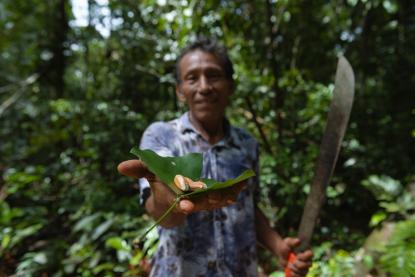How do REDD+ forest conservation projects work?

Why is forest conservation so important?
Forests are some of the most important carbon sinks on the planet because they sequester around one third of humanity’s annual carbon emissions. They are also home to an enormous variety of species and are the basis of human life. However, global forest areas have sharply declined in recent decades due to increasing settlement, agricultural use, illegal logging, and mining.
Together, deforestation and permanent land use change – which include agriculture and cattle grazing – have been responsible for 23% of the anthropogenic greenhouse gas emissions registered around the world since 1961.
The Food and Agriculture Organization (FAO) estimates that global wood consumption will rise by 50% by 2050. This constantly rising demand will greatly increase the pressure on existing forests. As a result, it is now more important than ever to support afforestation, forest conversion, and forest conservation projects.
What are REDD+ projects all about?
Measures to protect forests are vital to combatting deforestation. Created by the United Nations in 2008, the REDD+ mechanism is a key part of this climate action. REDD stands for ‘Reducing Emissions from Deforestation and Degradation’. The ‘+’ signifies the importance of forest conservation, sustainable forest management and the enhancement of forest carbon stocks in developing countries.
REDD+ aims to avoid carbon emissions that are linked to deforestation.
The purpose of REDD+ is to involve the local population in forest conservation and reward them for their work to protect the forests. Instead of felling trees to earn money, REDD+ strives to turn their conservation and protection into a basis for new business models and the livelihoods of the local population: reducing forest clearing can generate verified emission reductions, which in turn help to protect existing woodlands. These verified emission reductions can be sold to make the forests more financially attractive than other forms of land-use. In turn, the income from the sale of verified emission reductions is invested in forest conservation, the sustainable management of forest resources, and, in particular, prospects for the local population, such as new jobs and education. This way, the REDD+ mechanism enables communities to play an active role in the fight against global warming, while promoting social development in their local areas.
In some cases, wood can be harvested sustainably in REDD+ projects: it must have an FSC (Forest Stewardship Council) certification and the sustainable forest management must be consistent with the relevant laws and regulations.

The positive impacts of REDD+ projects
REDD+ projects have lots of positive impacts on people and the environment. These include:
What are the challenges?
Forest conservation projects only work if the forest is protected on a long-term basis. A forest fire would release the sequestered CO2 again. Forest conservation projects account for this risk by setting aside verified emission reductions to form a ‘pooled buffer’ – these verified emission reductions are not for sale. This method acts like a type of insurance. On the basis of an individual risk assessment, every project must contribute a certain number of verified emission reductions to this pooled buffer. These are managed by the standards and may not be traded. If, for example, a forest fire does break out, verified emission reductions from this buffer are retired based on how much wooded area was lost in order to offset the lost emission reductions. To avoid such risks and guarantee the permanence of a project, risk assessments are carried out and additional buffer zones are then set up around the project area.
This means that every forest conservation project actually sequesters far more CO2 than it is allowed to ‘trade’, so a project can never claim 100 percent of the emission reductions it accomplishes. This conservative formula is set out by the internationally recognised Verified Carbon Standard.
REDD+ projects with ClimatePartner
Many of our climate projects that are involved with forest conservation work with the REDD+ mechanism, such as the forest conservation projects in Madre de Dios – Peru, Portel – Brazil and Tambopata – Peru.
Our REDD+ projects comply with the Verified Carbon Standard or the PV Climate Standard, which means that they are certified under the strictest quality standards. Under these standards, certified climate projects must meet the following four criteria: they must be additional, they must exclude double counting, they must be permanent and they must be audited by independent third parties on a regular basis.
Would like to get in touch with us? Please feel free to contact us.